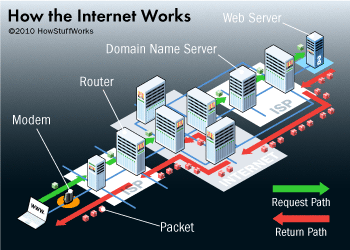I got this info from Howstuffworks
Suppose you want to connect to
Tamil Brahmins Forum - Brahmins World. First, you open your Web browser and type the corresponding address and enter. When you do this, your computer sends an electronic request over your Internet connection to your
Internet service provider (ISP). The ISP routes the request to a server further up the chain on the Internet. Eventually, the request will hit a
domain name server (DNS).
This server will look for a match for the domain name you've typed in (such as
Tamil Brahmins Forum - Brahmins World). If it finds a match, it will direct your request to the proper server's IP address. If it doesn't find a match, it will send the request further up the chain to a server that has more information.
The request will eventually come to the Web server of tamilbrahmins. The server will respond by sending the requested file in a series of packets.
Packets are parts of a file that range between 1,000 and 1,500 bytes. Packets have headers and footers that tell computers what's in the packet and how the information fits with other packets to create an entire file. Each packet travels back up the network and down to your computer. Packets don't necessarily all take the same path -- they'll generally travel the path of least resistance.
I shall attach schematic diagram in next post

